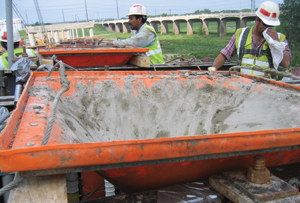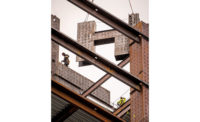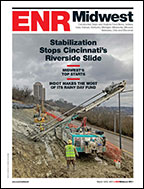Even though the U.S. Army Corps of Engineers has required more soil testing at the site of the future Margaret Hunt Hill Bridge in Dallas, construction continues on other portions of the structure, which is part of the Trinity River Corridor Project.


“It’s coming along,” says Rebecca Dugger, director of the Dallas Trinity River Corridor Project for the city of Dallas. “It’s still moving forward.”
Williams Bros. Construction Co. of Houston received the $69-million contract from the Texas Department of Transportation to build the six-lane, 0.366-mi, cable-stay, suspension bridge, designed by Spanish architect Santiago Calatrava. J.D. Abrams of Austin secured the $47.4-million contract to build the east and west, six-lane approaches to the Trinity River, outside the levees of the Dallas Floodway.
The bridge will extend Spur 366, the Woodall Rodgers Freeway, across the Trinity River. It is one of three bridges planned for the corridor.
The bridge’s official groundbreaking took place in December 2005, but construction did not begin until June 2007 on the span, says TxDOT spokesman Tony Hartzel. At that time, the expected completion date was early 2010. Abrams started work on the approaches in October, and now the new target for the entire project and anticipated finish date of the bridge is mid-2011.
The bridge underwent a redesign process, after Williams Bros.’ first bid came in significantly higher than estimated, $113 million vs. the $57 million Calatrava projected. The city had raised private funds to pay for the design of a signature bridge, rather than a planned, simple suspension bridge, which was approved as part of a 1998 bond program.
“It’s very dramatic, 400-ft tall, and there will be nothing like it in this country,” Dugger says. The Margaret Hunt Hill Bridge will be the first vehicular bridge designed by Calatrava in the United States. He also has designed a pedestrian bridge in California.
After the initial bid came in high, the city approved changing the seven-side arch and the teardrop-shaped columns to cylinders to save money.
“It was just making shapes easier to fabricate,” Dugger says.
TxDOT also divided the project into two parts, which Dugger says was done for two reasons: The span was ready for construction before the approaches and could get started sooner, and there was a desire to use foreign steel. But federal regulations preclude foreign steel unless the bid for the entire project is 25% less than what it would cost for domestic steel.
“Since we were ready to go on the signature span and wanted to try the foreign steel angle to get the price lower, we went ahead and bid it [separately],” Dugger adds.



Post a comment to this article
Report Abusive Comment